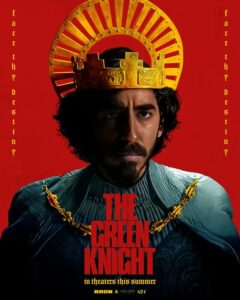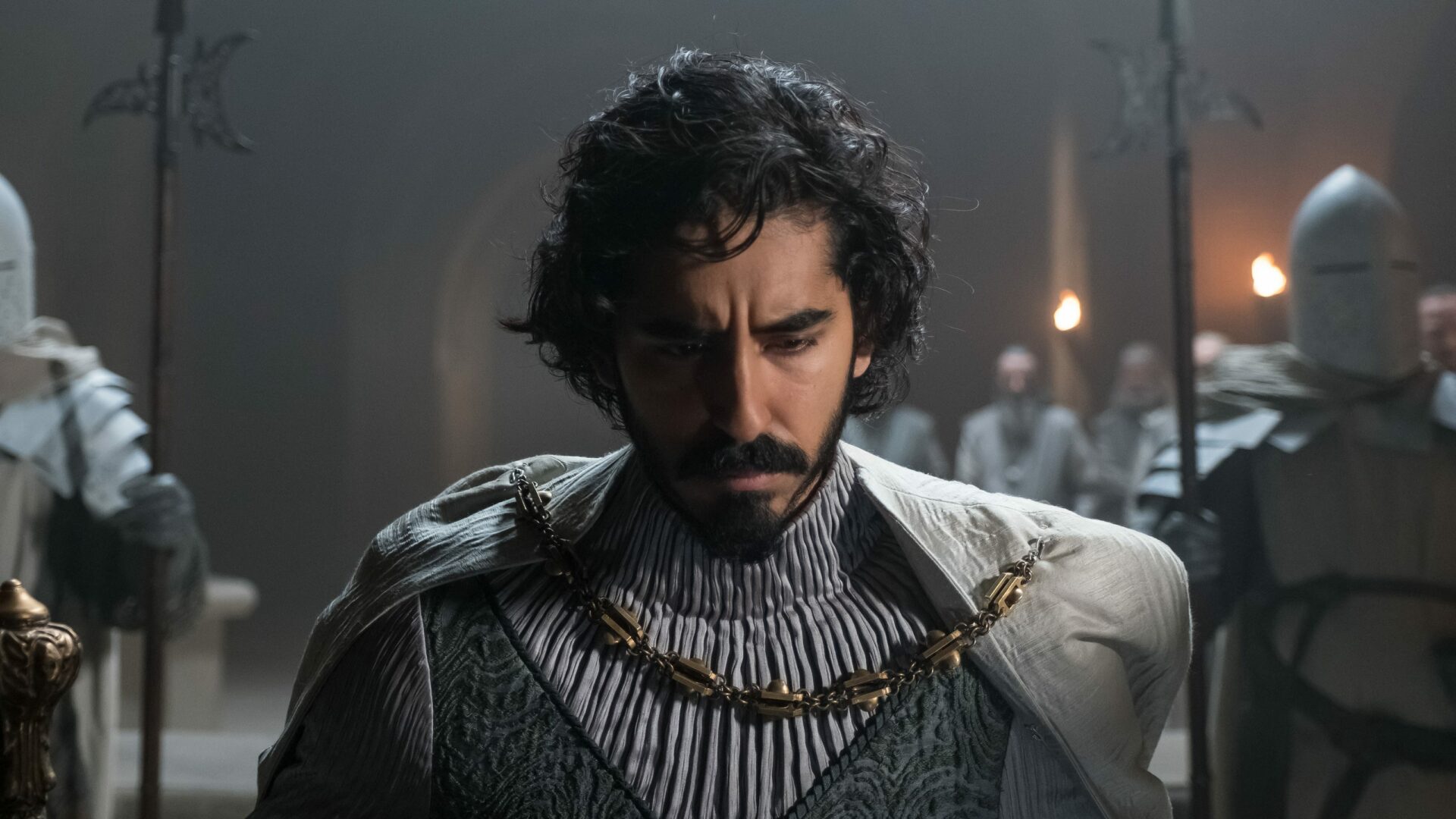Vilonia, AR. Award-winning film and TV studio A24, the same company that brought us Minari, has released their latest movie The Green Knight (2021). Written, directed, and produced by David Lowery, it is based on one of the oldest stories in the Western Canon, Sir Gawain and the Green Knight (SGGK), written at about the same time as The Canterbury Tales. A24 provides an oral history with key thematic elements to help sharpen viewers attention on the main thing: “honor should be our guiding light through our darkest journeys.” First and foremost the The Green Knight is a “far reaching, culturally resonant, mythic morality tale.” Lowery points toward J.R.R. Tolkien as a reliable source in comprehending what other reviewers find to be difficult and obscure. In A24’s guide to the film, emphasis is placed on the miraculous recovery of the manuscript in the 1731 tragic fire of the Cotton Library, in which Beowulf also survived. In this context, the importance of the poem is providential and fortuitous.
 Faithful to the “peculiar degree or mode” found in the four stages of fairy-story—Fantasy, Recovery, Escape, and Consolation—the film does not violate Tolkien’s schema in On Fairy Stories. Lowery is also hinting toward C.S. Lewis’ Discarded Image in which the Medieval Model is “syncretic…not only out of Platonic, Aristotelian and Stoical, but out of Pagan and Christian elements.” The literary inheritance of the Middle Ages was cumulative, formed by a series of authors and sources, rather than an individual, especially the Arthurian legends. According to Lewis, Mallory was “doing a few demolitions here and adding a few features there.”
Faithful to the “peculiar degree or mode” found in the four stages of fairy-story—Fantasy, Recovery, Escape, and Consolation—the film does not violate Tolkien’s schema in On Fairy Stories. Lowery is also hinting toward C.S. Lewis’ Discarded Image in which the Medieval Model is “syncretic…not only out of Platonic, Aristotelian and Stoical, but out of Pagan and Christian elements.” The literary inheritance of the Middle Ages was cumulative, formed by a series of authors and sources, rather than an individual, especially the Arthurian legends. According to Lewis, Mallory was “doing a few demolitions here and adding a few features there.”
The most important element of both the poem and the film are symbolic. You may find yourself hopelessly lost if you don’t have a sherpa. ScreenRant has done an excellent job regarding some of the “features” Lowery added to the Arthurian tale, such as the Scavenger (Barry Keoghan), Winifred (Erin Kellyman), the strange giants that offer help (and that must be rejected), and a talking fox; who is both sly and wise simultaneously. Lowery, by introducing mushroom activated hallucinations is signaling the sub-conscience world of archetypes; a reference to Joseph Campbell’s The Hero with a Thousand Faces. A relevant topic today among young college-aged men who follow popular podcasts (such as Joe Rogan) on the topic of micro-dosing mushrooms. That young men seek the experience is an indication that our culture is devoid, yet desiring a life-changing, dangerous “hero’s journey.” This is the “longing” felt in Arthur’s court on Christmas Day in the medieval SGGK, which focuses on the youth of both the King and his knights.
Each feature Lowery adds represents a test of virtue that Gawain (Dev Patel) fails, though he makes half-hearted attempts. It is worth noting the consequences of half-measures, as events are set in motion with the first test of generosity. The Scavenger steals the Green Knight’s ax and uses it against an innocent woman. Yet, the responsibility for the act is placed on Gawain, who shows signs of immaturity in not foreseeing the consequences of his actions. Winifred, who has been decapitated for spurning the sexual advances of a suitor, thinks that Gawain looks like the person who assaulted her (once her head is returned). Gawain has the nerve to ask what she will give him for his courtesy. It is implied that he is asking for sexual favors. Lowery is cleverly showing the outworking of less than chivalrous intentions. It is a matter of the heart, as well as the actions.
The Green Knight is unapologetic in its focus on honor. Lowery emphasizes Tolkien as a foremost scholar in regard to the poem, quoting him as stating that it is “a window of multi-colored glass looking back into the Middle Ages.” Near the end of his journey Gawain asks Lady Bertilak (Alicia Vikander) why she has so many books in her library. She tells him that she has read all of them, as well as wrote them with improvement. “I make them,” she states matter-of-factly. This is the “medieval” view that Tolkien, Lewis, and Lowery embrace. Like the Arthurian authors before him, Lowery is a “maker.” As a palimpsest, something reused or altered, but still bearing visible traces of its earlier form, The Green Knight joyfully succeeds. Tolkien would approve of Lowery’s sub-created tale of Faërie.
If you are seeking the typical fantasy/action film, you will not be happy with the slightly more than two-hour time investment. The poem and the film are not about strength of body in fighting, or external hazards, for Gawain is already a skilled warrior. The Green Knight does not come to fight, but voluntarily lays his neck open for the cut. Both tales are about existential internal threats to the wholeness of being; an ax to the root is the remedy, as opposed to the branch. It is “artsy” as they say, extraordinarily visual, and highly symbolic, like any good poetry should be. If you are looking for it to mirror the original SGGK precisely, be warned: it does not. It does something better; it “expands” the original meaning.
Do not see this film if you are offended with the depiction of the worst in a young man’s lustful desires (the film is rated R for overt sexuality and nudity). Gawain is not yet a knight when the story begins. Remember, it is a “culturally resonant … mythic morality tale” which is courageous in our current age in which debauchery is celebrated. Lowery is signaling us back to the development of Christian chivalry that defended and protected women (and children) by training men in a code of knightly honor. The opening scene of the movie takes place in a brothel on Christmas Eve. To the pure in heart, this opening is an assault, especially when we think of the original Gawain who excelled in the poem. Lowery is perhaps purposely “jolting” us to see things as they are in our present culture where innocence is hardly allowed anywhere, and for any age group.
If you are looking for many of the same truths found in the medieval poem, only told in a thoroughly modern context of frail and deeply flawed humanity, you will surely cheer the idea of stubborn (universal) virtue. Truth in this medieval context signifies not just honesty, but the five attributes of generosity, courtesy, fellowship, chastity, and piety. These are considered essential to the chivalric code and are what all knights are meant to aspire to. Gawain’s mother does not approve his wastrel ways; rather, she seeks to instruct him in the Pentagonal Virtues.
In the film version, Gawain is abandoned by his uncle King Arthur (Sean Harris), who apologizes for not getting to know him. He realizes that Gawain has no tale to tell. His knightly virtue has not been a going concern of the aged King, until now. While Shakespeare’s Henry the V chafed against the strictures of his father’s court and left to spend the days of his youth in brothels, Gawain’s longing look at Arthur conveys the inverse; he would have gladly spent his time in his uncle’s court had he been invited. Arthur’s sister Morgause is the traditional mother of Gawain. In Lowery’s version, it is Morgan le Fay (Sarita Choudhury), the more powerful sister who orchestrates the beheading exchange game from top to bottom in the poem and the film.
In the poem, Morgan’s motives bring unintended good to her nephew Gawain, but Lowery is intentional in showing the lengths a mother will go in helping her son mature in the knightly chivalric code. She begins with the lessons the natural world can teach. As a single and widowed mother, I have written much on the topic of raising boys in the mud and streams of a natural landscape—rural living provides many trials and temptations of a metaphorical quest that ends at a Green Chapel, if you’re lucky. It is a good mother who finds cruelty not in the hardships her son must face, but in the softness of a wanton life without responsibility. Young men are especially susceptible, and the consequences are suffered chronically and generationally by women, children, and kingdoms, as the film illustrates so well.
The original poem is a thoroughly Christian tale. It is Christmas in King Arthur’s court when Þer hales in at þe halle dor an aghlich mayster — “a hair-raising stranger, the biggest and bulkiest man above ground … halfway a giant on earth,” storms through the doors like a burst of lightning, electrifying the atmosphere. His actions are hostile, for who dares ride his steed into the King’s court? A bold enigma, he “s[its] on soft stockings” and “wishing no war, [he] c[omes] wearing soft garments.” His visage is hauntingly strange…and unnatural, for he is “top to toe bright green!” He is familiar in the natural knowing of a thing, like the medieval air they breathed on that winter’s day, or the etchings of a leaf-faced wild man in a cathedral. This Green Knight was both fearful, for it seemed that no one might “withstand the strokes he’d ply” and yet meek: “while in one hand he held a holly bob,” a sign of peace. Both characteristics are present in the film.
King Arthur is filled on that holy day with much that a man could desire: a kingdom at peace, love of a beautiful woman, loyal knights, laughter, food, and festivities. Yet, something is missing. He longs for a fantastical story, something more true than the material world that surrounds him; something more alive than the blood coursing through his veins at the arrival of the Green Knight, his “first gift of the season.” The intensely missing something or somewhere — not yet found, was awakened with possibility in the other-worldly green man mounted on his steed.
King Arthur’s best “havings were wantings,” as C.S. Lewis described in the concept of sehnsucht. The appearance of the Green Knight is the catastrophe on which we find the foundation for both Arthur’s longing of a fantastic tale, and what J.R.R. Tolkien called a “rash adventure” in a “perilous land”—a Faërie-story. This realm “cannot be caught in a net of words; for it is one of its qualities to be indescribable, though not imperceptible.” Not imperceptible because in some strange and magical way Faërie approximates temporary satisfaction of that which is critically absent in this world. But: is absent in this world synonymous with untrue? The anonymous author of SGGK and Lowery do not think so.
In dealing with Faërie one should understand that whether something is true based on whether it could happen in real life is not the proper criteria, for we are not “primarily concerned with possibility, but desirability.” After hearing of a Green Knight whose severed head could talk, a child may pose the question “Is it true?” They are not asking if they can expect to run into a giant at the school bus stop, holding his head in the air. It is not a question of safety in this world, but a true heart longing for the perilous adventure in that other world, “for the heart is hard though the body be soft.”
In the poem, Gawain is already a knight on this Christmas Day, with all the virtues intact, or so he believes. His quest is what Tolkien coined a “re-gaining—regaining of a clear view.” Full of almost every kind of virtue, like the rich young ruler in his self-description to Christ, he has a blind spot to which there was no conscience self-deceit, only deep familiarity. In the film, Gawain also suffers from familiarity. An upside-down world shakes him loose from his apathy; thus we experience the topsy-turvy camera shots.
Like King Lear, he “slenderly” knows himself for the scoundrel he is toward his peasant lover Essel (also played by Alicia Vikander). In this “doubling” effect, Lowery reimagines Essel as Lady Bertilak, an often used literary device in the Bible, as well as Shakespeare. Essel emphasizes that she wants to be Gawain’s “Lady”—and some reviewers point out that it is the “class system” that ultimately impedes them. While true at the surface level, there is rumbling underneath this structure that will ultimately succeed: the chivalric code. It is the “morality tale” that Lowery is most interested in, therefore is Gawain’s eros (the Greek form of erotica) a sustaining love apart from the virtues?
With another link to perhaps Lewis’ greatest scholarship in medieval studies, his seminal work, The Allegory of Love, (and later, The Four Loves), Lowery connects eros to bad behavior associated with Essel, Winifred, and Lady Bertilak. Read: The #MeToo movement. It is the Lady who ask him if he “will sit for a portrait.” He must “hold very still” to give her time to paint his image. In the brothel he tells Essel that he has “lots of time.” Once completed, Gawain’s portrait is inverted, indicating that he does not see the world rightly. Women are not possessions, or objects to satisfy male desire, and his time is limited—just as King Arthur’s is.
Establishing a fresh look at old things, Tolkien likens it to the washing of a window “so that the things seen clearly may be freed from the drab blur of triteness or familiarity—from possessiveness.” Things may be acquired either legally, such as bought at a market, or mentally, such as grasped or understood with the mind. People, though not rightly in this category, are often mistaken as a thing to possess. Tolkien tells us “Of all faces, those of our familiares are the ones … most difficult really to see with fresh attention.” Lowery’s Gawain will see not just himself and those around him with new eyes, but his entire future—should he “cheat” the game—is shown him in a vision at the Green Chapel. The Green Knight has given him a tremendous gift: the ability to see.
Though we are left with a somewhat uncertain ending, the Green Knight’s laughter is a clue, as is the kiss that Lord Bertilak de Hautdesert (Joel Edgerton) gives to Gawain (even though he fails the test of friendship to his gracious host). In the poem, it is the Green Knight, symbolic of Christ, who actually pays the ultimate price. In losing his head for the sins of Gawain, the deeper magic is found in the idea that a “head for a head” was no longer required in the exchange game. The “green man gave over and grounded his axe,” and justice was served. “I clear you completely of all other claims,” stated the Green Knight to Gawain. Both the unknown author of SGGK and Lowery end with a great Eucatastrophe, a sudden good turn of events. It is the center of the evangelium, the Gospel, the good news.
Then the other lord laughed and lovingly said / I hold it made whole, any harm that I had / You are cleanly confessed, sir, and cleared of your faults. The matter was severed clean through — on the point of my blade / I dispense with your promise; you’re polished as clean / As if you’d not erred since you stepped on this earth.
After Recovery, in Tolkien’s theory, comes Escape. With the declaration of being “cleared of [his] faults” and “polished as clean,” Sir Gawain’s Escape is not of the ordinary fairy-tale variety. He is not just a prisoner to be set free, he has in fact accomplished the “oldest and deepest desire, the Great Escape: the Escape from Death.” Gawain’s Fantasy and Recovery were not of the milquetoast variety. There was more at stake than Chivalric virtue, honor, courtesy, or even a kingdom (for what does it profit a man to gain the world and lose his soul?). Gawain’s temporal and eternal life are in peril, and he Escaped with both in the poem. In the film, we are left to wonder about the temporal, but we are satisfied that when Lowery’s Gawain removes the green belt, he has won his soul.
The Green Knight and SGGK are about longing, not just for another world—a world more real than this one—but for a chance to be made whole: another garden, another test, another Adam. Gawain wants to “return home a changed man.” The perilous journey, from and into “a world fit for all manner of mysteries” where homes are “filled with strange things” and a “hawk kills a horse” engenders fear, and rightfully so. But if not cheated, circumvented, or half-way done, it has the potential to transform us, bringing the “holly bob” of peace. As Gawain and the Lady talk about why the knight is green (a color of living things, but also symbolic of death as nature receives us back to itself), she tells him “Red is the color of lust, but green is what lust leaves behind … it is what’s left when ardor fades, when passion dies and we die too.” This subversive film that recommends the culturally decaying virtues of generosity, courtesy, fellowship, chastity, and piety is a true myth worth telling.





